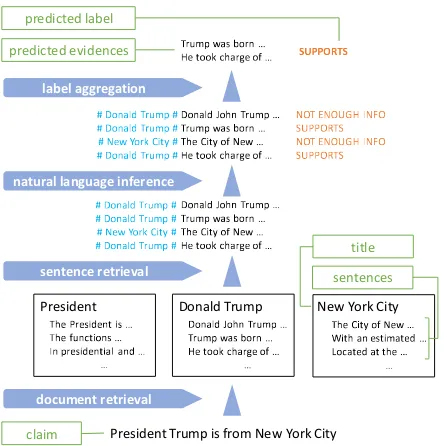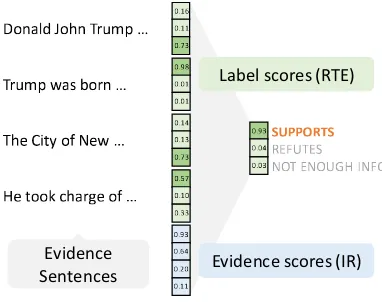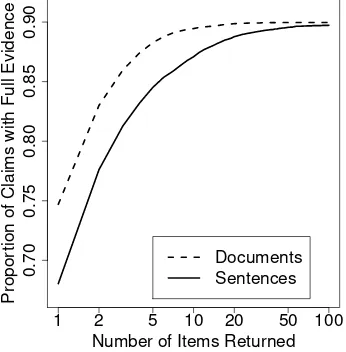97
UCL Machine Reading Group:
Four Factor Framework For Fact Finding (HexaF)
Takuma Yoneda
Computational Intelligence Lab. Toyota Technological Institute
sd18438@toyota-ti.ac.jp
Jeff Mitchell, Johannes Welbl, Pontus Stenetorp, Sebastian Riedel
Dept. of Computer Science University College London
{j.mitchell, j.welbl,
p.stenetorp, s.riedel}@cs.ucl.ac.uk
Abstract
In this paper we describe our 2nd
place FEVER shared-task system that achieved a FEVER score of 62.52% on the provisional test set (without additional human evaluation), and 65.41% on the development set. Our sys-tem is a four stage model consisting of docu-ment retrieval, sentence retrieval, natural lan-guage inference and aggregation. Retrieval is performed leveraging task-specific features, and then a natural language inference model takes each of the retrieved sentences paired with the claimed fact. The resulting predic-tions are aggregated across retrieved sentences with a Multi-Layer Perceptron, and re-ranked corresponding to the final prediction.
1 Introduction
We often hear the word “Fake News” these days. Recently, Russian meddling, for example, has been blamed for the prevalence of inaccurate news stories on social media,1but even the reporting on this topic often turns out to be fake news (Uberti,
2016). An abundance of incorrect information can plant wrong beliefs in individual citizens and lead to a misinformed public, undermining the demo-cratic process. In this context, technology to au-tomate fact-checking and source verification ( Vla-chos and Riedel,2014) is of great interest to both media consumers and publishers.
The Fact Extraction and Verification (FEVER) shared task provides a benchmark for such tools, testing the ability to assess textual claims against a corpus of around 5.4M Wikipedia articles. Each claim is labeled asSUPPORTS,REFUTESorNOT
ENOUGH INFO, depending on whether relevant
evidence from the corpus can support/refute it. Systems are evaluated on the proportion of claims for which both the predicted label is correct and
1
https://www.bbc.co.uk/news/world-us-canada-41821359
ƉƌĞĚŝĐƚĞĚĞǀŝĚĞŶĐĞƐ ƉƌĞĚŝĐƚĞĚůĂďĞů
ĐůĂŝŵ WƌĞƐŝĚĞŶƚdƌƵŵƉŝƐĨƌŽŵEĞǁzŽƌŬŝƚLJ
^hWWKZd^
ĚŽĐƵŵĞŶƚƌĞƚƌŝĞǀĂů ŶĂƚƵƌĂůůĂŶŐƵĂŐĞŝŶĨĞƌĞŶĐĞ
ůĂďĞůĂŐŐƌĞŐĂƚŝŽŶ
WƌĞƐŝĚĞŶƚ dŚĞWƌĞƐŝĚĞŶƚŝƐ͙ dŚĞĨƵŶĐƚŝŽŶƐ͙ /ŶƉƌĞƐŝĚĞŶƚŝĂů ĂŶĚ͙
͙
ŽŶĂůĚdƌƵŵƉ ŽŶĂůĚ:ŽŚŶdƌƵŵƉ͙ dƌƵŵƉǁĂƐďŽƌŶ͙ ,ĞƚŽŽŬĐŚĂƌŐĞŽĨ͙
͙
EĞǁzŽƌŬŝƚLJ dŚĞŝƚLJŽĨEĞǁ͙ tŝƚŚĂŶĞƐƚŝŵĂƚĞĚ͙ >ŽĐĂƚĞĚĂƚƚŚĞ͙
͙ ŽŶĂůĚ:ŽŚŶdƌƵŵƉ͙
dƌƵŵƉǁĂƐďŽƌŶ͙ dŚĞŝƚLJŽĨEĞǁ͙ ,ĞƚŽŽŬĐŚĂƌŐĞŽĨ͙ ŽŶĂůĚ:ŽŚŶdƌƵŵƉ͙ dƌƵŵƉǁĂƐďŽƌŶ͙ dŚĞŝƚLJŽĨEĞǁ͙ ,ĞƚŽŽŬĐŚĂƌŐĞŽĨ͙
ηŽŶĂůĚdƌƵŵƉη ηŽŶĂůĚdƌƵŵƉη ηEĞǁzŽƌŬŝƚLJη ηŽŶĂůĚdƌƵŵƉη
EKdEKh',/E&K ^hWWKZd^ EKdEKh',/E&K ^hWWKZd^
ηŽŶĂůĚdƌƵŵƉη ηŽŶĂůĚdƌƵŵƉη ηEĞǁzŽƌŬŝƚLJη ηŽŶĂůĚdƌƵŵƉη
dƌƵŵƉǁĂƐďŽƌŶ͙ ,ĞƚŽŽŬĐŚĂƌŐĞŽĨ͙
ƐĞŶƚĞŶĐĞƌĞƚƌŝĞǀĂů
ƚŝƚůĞ
[image:1.595.307.529.225.448.2]ƐĞŶƚĞŶĐĞƐ
Figure 1: Illustration of the model pipeline for a claim.
a complete set of relevant evidence sentences has been identified.
an explicit aggregation step to combine the knowl-edge gained from each evidence sentence. These improvements allow us to achieve a FEVER score of 65.41% on the development set, and 62.52% on the test set.
2 System Description
Our system is a four stage model consisting of document retrieval, sentence retrieval, NLI and ag-gregation. Document retrieval attempts to find the name of a Wikipedia article in the claim, and then ranks each article based on capitalisation, sentence position and token match features. A set of sen-tences are then retrieved from the top ranked arti-cles, based on token matches with the claim and position in the article. The NLI model is subse-quently applied to each of the retrieved sentences paired with the claim, giving a prediction for each potential evidence sentence. The respective pre-dictions are aggregated using a Multi-Layer Per-ceptron (MLP), and the sentences are finally re-ranked so that the evidence which is consistent with the final prediction are placed at the top.
2.1 Document Retrieval
Our method begins by building a dictionary of arti-cle titles, based on the observation that the FEVER claims frequently include the title of a Wikipedia article containing the required evidence. These ti-tles are first normalised by lowercasing, convert-ing underscores to spaces and truncatconvert-ing to the first parenthesis if present. An initial list of po-tential articles is then constructed by detecting any such title in the claim. For each article, the proba-bility of containing the gold evidence is predicted by a logistic regression model, using as features the position and capitalisation within the claim, presence of stop words, and token match counts between the first sentence of the article and the claim. Likewise we include the same counts also for the rest of the article as features, alongside whether the name was truncated, and whether the excised words are mentioned in the claim (e.g., “Watchmen”vs“Watchmen (film)”).
The model is trained on a balanced set of pos-itive and negative examples drawn from the train-ing set, and the top-ranked articles are then passed on to the sentence retrieval component.
This process is related to, but goes substantially beyond entity recognition and linking (Mendes et al.,2017). These processes attempt to identify
^hWWKZd^
Z&hd^ EKdEKh',/E&K ,ĞƚŽŽŬĐŚĂƌŐĞŽĨ͙
ŽŶĂůĚ:ŽŚŶdƌƵŵƉ͙
dƌƵŵƉǁĂƐďŽƌŶ͙
dŚĞŝƚLJŽĨEĞǁ͙
ǀŝĚĞŶĐĞƐĐŽƌĞƐ;/ZͿ >ĂďĞůƐĐŽƌĞƐ;ZdͿ
ǀŝĚĞŶĐĞ ^ĞŶƚĞŶĐĞƐ
Ϭ͘ϭϲ Ϭ͘ϭϭ Ϭ͘ϳϯ
Ϭ͘ϵϴ Ϭ͘Ϭϭ Ϭ͘Ϭϭ
Ϭ͘ϭϰ Ϭ͘ϭϯ
Ϭ͘ϳϯ
Ϭ͘ϱϳ Ϭ͘ϭϬ Ϭ͘ϯϯ
Ϭ͘ϵϯ Ϭ͘ϲϰ
Ϭ͘ϮϬ Ϭ͘ϭϭ
[image:2.595.311.502.67.218.2]Ϭ͘ϵϯ Ϭ͘Ϭϰ Ϭ͘Ϭϯ
Figure 2: Overview: Aggregation Network
mentions of names from a limited class of enti-ties (e.g. people, places, organisations). In our case, the mentions cover a much wider range of lexical items, including not only names but also common nouns, verbs or adjectives. Nonetheless, both types of model share the objective of finding mentions and linking them to a reference set.
2.2 Sentence Retrieval
We observed that many evidence sentences appear at the beginning of an article, and they often men-tion the article title. We thus train a logistic re-gression model, using as features the position of the sentence within the article, its length, whether the article name is present, token matching be-tween the sentence and the claim, and the doc-ument retrieval score. The top-ranked sentences from this model are then passed to the subsequent NLI stage.
2.3 Natural Language Inference (NLI)
In this component, an NLI model predicts a la-bel for each pair of claim and retrieved evidence
sentence. We adopted the Enhanced
Sequen-tial Inference Model (ESIM) (Chen et al., 2017) as NLI model. ESIM employs a bidirectional LSTM (BiLSTM) to encode premise and hypoth-esis, and also encodes local inference information so that the model can effectively exploit sequen-tial information. We also experimented with the Decomposable Attention Model (DAM) (Parikh et al., 2016) — as used in the baseline model, however ESIM consistently performed better. The Jack the Reader (Weissenborn et al.,2018) frame-work was used for both DAM and ESIM.
on the FEVER dataset. We used 300-dimensional pre-trained GloVe word embeddings (Pennington et al.,2014). As training input, we used gold
ev-idence sentences for SUPPORTS and REFUTES
samples, and retrieved evidence sentences forNOT
ENOUGH INFO.
It is worth noting that there are two kinds of ev-idences in this task. The first is a complete set of evidence, which can support/refute a claim, and can consist of multiple sentences. The second is incomplete evidence, which can support or refute the claim only when paired with other evidence.
The baseline model (Thorne et al., 2018) sim-ply concatenates all evidence sentences and feeds them into the NLI model, regardless of their ev-idence type. In contrast, we generate NLI pre-dictions individually for each predicted evidence, thus processing them in parallel.
Furthermore, we observed that evidence sen-tences often include a pronoun referring to the subject of the article without explicitly mentioning it. This co-reference is opaque to the NLI model without further information. To resolve this, we prepend the corresponding title of the article to the sentence, along with a separator as described in Figure1. We also experimented with adding line numbers to represent sentence position within the article, which did not, however, improve the label accuracy.
&ƌŽnjĞŶƌĂŶŬƐĂƐƚŚĞƐĞĐŽŶĚͲŚŝŐŚĞƐƚͲŐƌŽƐƐŝŶŐ ŽƌŝŐŝŶĂůĨŝůŵŽĨĂůůƚŝŵĞ͘ /ƚƌĂŶŬƐĂƐƚŚĞŚŝŐŚĞƐƚͲŐƌŽƐƐŝŶŐĂŶŝŵĂƚĞĚĨŝůŵŽĨĂůůƚŝŵĞ͘ ůĂŝŵ
ǀŝĚĞŶĐĞ
η&ƌŽnjĞŶͺ;ϮϬϭϯͺĨŝůŵͿ η/ƚƌĂŶŬƐĂƐƚŚĞŚŝŐŚĞƐƚͲŐƌŽƐƐŝŶŐĂŶŝŵĂƚĞĚĨŝůŵŽĨĂůůƚŝŵĞ͘
Figure 3: Illustration for the co-reference problem with individual sentences: What ‘it’ refers to is not obvious for a NLI model.
2.4 Aggregation
In the aggregation stage, the model aggregates the predicted NLI labels for each claim-evidence pair and outputs the final prediction.
The NLI model outputs three prediction scores per pair of sentences, one for each label. In our aggregation model, these scores are all fed into an MLP, alongside the evidence confidence scores for each of the (ranked) evidence sentences. Since the label balance in the training set is significantly bi-ased, we give the samples training weights which are inversely proportional to the size of their re-spective class. We also experimented with draw-ing samples accorddraw-ing to the size of each class,
but using the full training data with class weights performed better. The final MLP model contains 2 hidden layers with 100 hidden units each and Rectified Linear Unit (ReLU) nonlinearities (Nair and Hinton,2010). We observed only minor per-formance differences when modifying the size and number of layers of the MLP.
Aside from this neural aggregation module, we also testedlogical aggregation, majority-vote and top-1 sentence. In logical aggregation, our module takes the NLI predictions for all evi-dence sentences, and outputs eitherSUPPORTSor
REFUTESif at least one of them has such a label,
andNOT ENOUGH INFO if all predictions have
that label. In cases where both SUPPORTS and
REFUTESappear among the predictions, we take
one from the highest ranked evidence. Majority-votecounts the frequency of labels among predic-tion and outputs the most frequent label. 15 pre-dicted evidence sentences are used in each aggre-gation method.
3 Results
3.1 Aggregation Results
Table1 shows the development set results of our model under the different aggregation settings. Note that the Evidence Recall and F1 metrics are calculated based on the top 5 predicted evidences. We observe that the Majority-vote aggregation method only reaches 43.94% of FEVER Score and 45.36% of label accuracy, either of which are much lower than other methods. Since there are only a few gold evidence sets for most claims, the majority of NLI predictions tend to be NOT
ENOUGH INFO, rendering a majority aggregation
method impractical.
Aggregation Method FEVER Score Label Accuracy Evidence Recall Evidence F1
Majority-vote 43.94 45.36 83.91 35.36
Top-1 sentence 63.36 66.30 84.62 35.72
Logical 64.29 68.26 85.03 36.02
MLP 65.41 69.66 84.54 35.84
Table 1: Development set scores for different aggregation methods, all numbers in percent.
❳ ❳
❳ ❳
❳ ❳
❳ ❳
❳ ❳
❳ Gold
Prediction
supports refutes not enough info Total
supports 5,345 336 985 6,666
refutes 827 4,196 1,643 6,666
not enough info 1,288 989 4,389 6,666
[image:4.595.91.264.301.477.2]Total 7,460 5,521 7,017 19,998
Table 2: Confusion matrix on the development set.
1 2 5 10 20 50 100
0.70
0.75
0.80
0.85
0.90
Number of Items Returned
Propor
tion of Claims with Full Evidence
Documents Sentences
Figure 4: Performance of retrieval models on the de-velopment set.
Finally, after obtaining the aggregated label with the MLP, the model re-sorts its evidence pre-dictions in such a way that those evidences with the same predicted label as the final prediction are ranked above those with a different label (see upper part of Figure 1). We observed that this re-ranking increased the evidence recall by 0.18 points (when used with MLP aggregation).
The overall FEVER score is the proportion of claims for which both the correct evidence is re-turned and a correct label prediction is made. We first describe the performance of the retrieval com-ponents, and then discuss the results for NLI.
3.2 Retrieval Results
On the development set, the initial step of iden-tifying Wikipedia article titles within the text of
the claim returns on average 62 articles per claim. These articles cover the full evidence set in 90.8% of cases and no relevant evidence is returned for only 2.9% of claims. Ranking these articles, us-ing the model described above, achieves 81.4% HITS@1, and this single top-ranked article con-tains the full evidence in 74.7% of instances. Tak-ing the text of the 15 best articles and rankTak-ing the sentences achieves 73.7% HITS@1, which is equivalent to returning the full evidence for 68% of claims. Figure 4 illustrates the performance of the IR components as the number of returned items increases.
4 Error Analysis
Table2shows the confusion matrix for the devel-opment set predictions. We observe that the sys-tem finds it easiest to classify instances labelled
asSUPPORTS, whereas using theNOT ENOUGH
INFOlabel correctly is most difficult.
We next describe some frequent failure cases of our model in the description below.
Limitations of word embeddings.
Numeri-cal expressions like years (1980s vs 80s) or months (January vs October) tend to have simi-lar word embeddings, rendering it is difficult for a NLI model to distinguish them and correctly
pre-dictREFUTEScases. This was the most frequent
error type encountered in the development set.
model can conclude that the second sentence fol-lows from the first one by simply aligning Bob withBobandcannot sleepwithawake. However, it sometimes fails to capture a correct alignment, which results in a fail prediction. For example, “Andrea Pirlo is an American professional foot-baller”vs“Andrea Pirlo is anItalianprofessional footballer who plays for anAmericanclub.”
Sentence Complexity. In some cases, just tak-ing an alignment is not enough to predict the cor-rect label. In these cases, the model needs to cap-ture the relationship between multiple words. For example, “Virginia keeps all computer chips man-ufactured within the state for use in Virginian elec-tronics.” vs. “Virginia’s computer chips became the state’s leading export by monetary value.”
5 Future Work
For the model to read sentences that includes nu-merical expressions correctly, it could be helpful to explicitly encode the numerical expression and obtain a representation that captures the numerical features (Spithourakis and Riedel, 2018). Lever-aging context-dependent pre-trained word embed-dings such as ELMo (Peters et al., 2018) could help dealing better with more complex sentences.
6 Conclusion
In this paper, we described our FEVER shared-task system. We employed a four stage frame-work, composed of document retrieval, sentence retrieval, natural language inference, and aggrega-tion. By applying task specific features for a re-trieval model, and connecting an aggregation net-work on top of the NLI model, our model achieves a score of 65.41% on the development set and 62.52% on the provisional test set.
Acknowledgments
This work has been supported by the Euro-pean Union H2020 project SUMMA (grant No. 688139), by an Allen Distinguished Investigator Award, and by an Engineering and Physical Sci-ences Research Council scholarship.
References
Samuel R. Bowman, Gabor Angeli, Christopher Potts, and Christopher D. Manning. 2015. A large anno-tated corpus for learning natural language inference.
In Proceedings of the 2015 Conference on Empiri-cal Methods in Natural Language Processing, pages 632–642. Association for Computational Linguis-tics.
Qian Chen, Xiaodan Zhu, Zhen-Hua Ling, Si Wei, Hui Jiang, and Diana Inkpen. 2017. Enhanced lstm for natural language inference. In Proceedings of the 55th Annual Meeting of the Association for Compu-tational Linguistics (Volume 1: Long Papers), pages 1657–1668. Association for Computational Linguis-tics.
Afonso Mendes, David Nogueira, Samuel Broscheit, Filipe Aleixo, Pedro Balage, Rui Martins, Sebastiao Miranda, and Mariana S. C. Almeida. 2017. Summa at tac knowledge base population task 2017. In Pro-ceedings of the Text Analysis Conference (TAC) KBP 2017, Gaithersburg, Maryland USA. National Insti-tute of Standards and Technology.
Vinod Nair and Geoffrey E. Hinton. 2010. Rectified linear units improve restricted boltzmann machines. InProceedings of the 27th International Conference on International Conference on Machine Learning, ICML’10, pages 807–814, USA. Omnipress.
Ankur P. Parikh, Oscar T¨ackstr¨om, Dipanjan Das, and Jakob Uszkoreit. 2016. A decomposable atten-tion model for natural language inference. CoRR, abs/1606.01933.
Jeffrey Pennington, Richard Socher, and Christopher D Manning. 2014. Glove: Global vectors for word representation. InEMNLP, volume 14, pages 1532– 1543.
Matthew E. Peters, Mark Neumann, Mohit Iyyer, Matt Gardner, Christopher Clark, Kenton Lee, and Luke Zettlemoyer. 2018. Deep contextualized word rep-resentations. CoRR, abs/1802.05365.
Georgios P. Spithourakis and Sebastian Riedel. 2018. Numeracy for language models: Evaluating and im-proving their ability to predict numbers. CoRR, abs/1805.08154.
James Thorne, Andreas Vlachos, Christos Christodoulopoulos, and Arpit Mittal. 2018. FEVER: a large-scale dataset for fact extraction and verification. InNAACL-HLT.
David Uberti. 2016. Washington post fake news story blurs the definition of fake news. Columbia Jour-nalism Review.
Andreas Vlachos and Sebastian Riedel. 2014. Fact checking: Task definition and dataset construction. InProceedings of the ACL 2014 Workshop on Lan-guage Technologies and Computational Social Sci-ence, pages 18–22, Baltimore, MD, USA. Associa-tion for ComputaAssocia-tional Linguistics.


